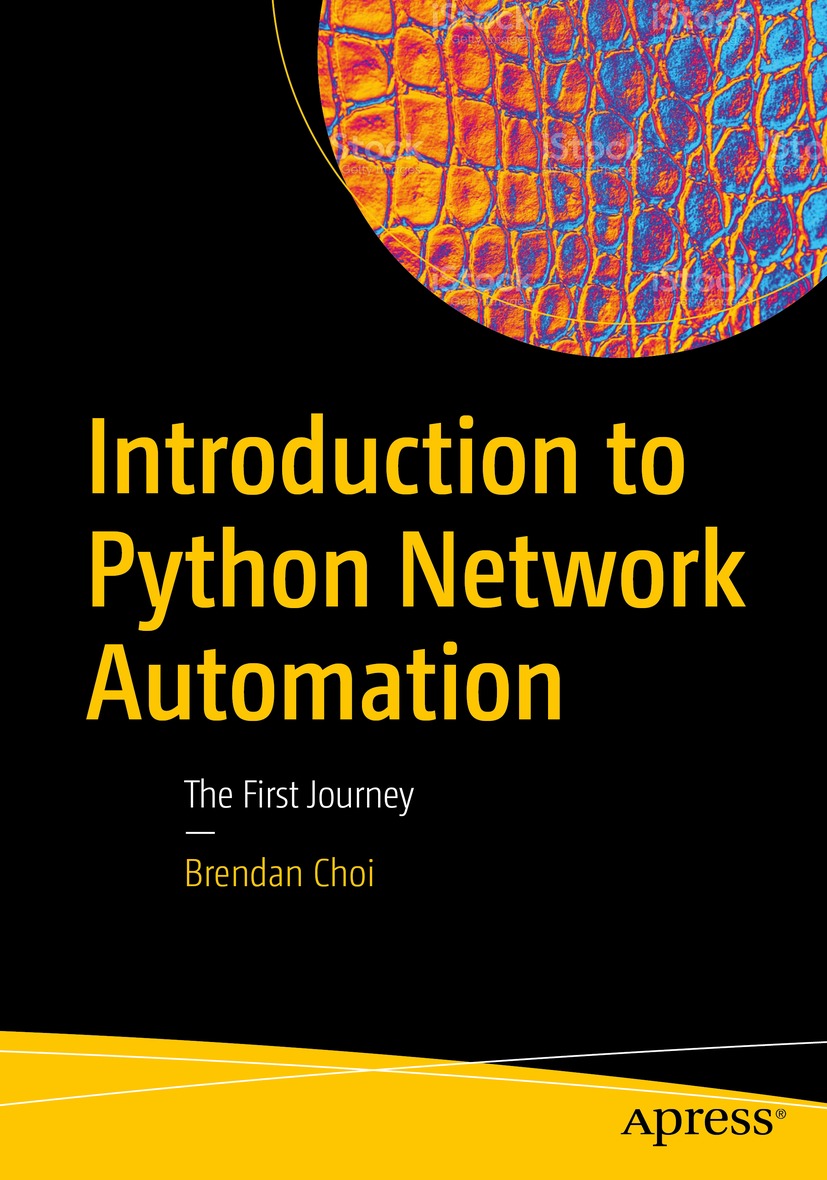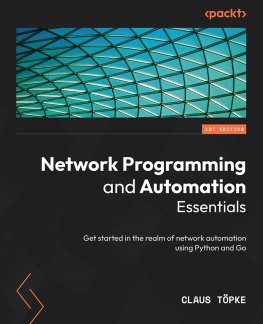Brendan Choi - Introduction to Python Network Automation(2021)[Choi][9781484268063]
Here you can read online Brendan Choi - Introduction to Python Network Automation(2021)[Choi][9781484268063] full text of the book (entire story) in english for free. Download pdf and epub, get meaning, cover and reviews about this ebook. year: 2021, publisher: Apress, genre: Home and family. Description of the work, (preface) as well as reviews are available. Best literature library LitArk.com created for fans of good reading and offers a wide selection of genres:
Romance novel
Science fiction
Adventure
Detective
Science
History
Home and family
Prose
Art
Politics
Computer
Non-fiction
Religion
Business
Children
Humor
Choose a favorite category and find really read worthwhile books. Enjoy immersion in the world of imagination, feel the emotions of the characters or learn something new for yourself, make an fascinating discovery.
- Book:Introduction to Python Network Automation(2021)[Choi][9781484268063]
- Author:
- Publisher:Apress
- Genre:
- Year:2021
- Rating:3 / 5
- Favourites:Add to favourites
- Your mark:
- 60
- 1
- 2
- 3
- 4
- 5
Introduction to Python Network Automation(2021)[Choi][9781484268063]: summary, description and annotation
We offer to read an annotation, description, summary or preface (depends on what the author of the book "Introduction to Python Network Automation(2021)[Choi][9781484268063]" wrote himself). If you haven't found the necessary information about the book — write in the comments, we will try to find it.
Brendan Choi: author's other books
Who wrote Introduction to Python Network Automation(2021)[Choi][9781484268063]? Find out the surname, the name of the author of the book and a list of all author's works by series.
Introduction to Python Network Automation(2021)[Choi][9781484268063] — read online for free the complete book (whole text) full work
Below is the text of the book, divided by pages. System saving the place of the last page read, allows you to conveniently read the book "Introduction to Python Network Automation(2021)[Choi][9781484268063]" online for free, without having to search again every time where you left off. Put a bookmark, and you can go to the page where you finished reading at any time.
Font size:
Interval:
Bookmark:


Any source code or other supplementary material referenced by the author in this book is available to readers on GitHub via the books product page, located at www.apress.com/978-1-4842-6805-6 . For more detailed information, please visit www.apress.com/source-code .
This Apress imprint is published by the registered company APress Media, LLC part of Springer Nature.
The registered company address is: 1 New York Plaza, New York, NY 10004, U.S.A.
For my wife Sue and children, Hugh, Leah, and Caitlin.
A decade ago, network engineer roles consisted of installing, configuring, maintaining, and troubleshooting LANs, WANs, and any other IP connectivity technologies. Practical working knowledge of networking concepts and strong networking protocol knowledge were must-have skills for network engineers. Some of these protocols included OSPF, EIGRP, BGP, MPLS, VRF, IPsec, QoS, DNS, VTP, VPN, Broadcast, Multicast, and GRE. Even then, the job requirements for a network engineer demanded real-world experience; broad application of the advanced principles, theories, concepts, and techniques of networking; and the ability to troubleshoot, report, and resolve a networking problem.
Roughly five years ago, network engineers were forced to take on more administrative responsibilities based on ITILs IT Service Management and ISO 9001s designated quality management standards. Middle management found a way to push down their administration work onto their subordinates. During this period, new buzzwords were invented by some tech geniuses and sold to the enterprise network market as the silver bullet to solve all of the IT industrys problems; these hot keywords were software-defined network and network automation . The introduction of these words hinted that the enterprise networking market was about to rapidly change. In fact, the industry started to demand more hybrid engineers with network programming skills on top of their existing responsibilities. In short, the market wanted more network engineers who could think and code like real application developers using one or more programming languages and open source programs. In line with the current market trend, Python has become one of the most popular programming languages among network engineers for networking task automation because of its ease of use and shorter development cycle. Python is not the only programming language used in network automation; other programming or scripting languages currently used include Shell, Bash, Perl, Java, API, Ansible, JSON, SOAP, Ruby, and REST.
Interestingly, a few years ago, not many organizations or engineers thought network engineers needed to know how to write code and develop automation scripts or applications. At that time, the network engineer role was clearly defined, with different groups of engineers divided based on the technology domain groups. Back then, the term network automation only meant creating ad hoc and simple Tcl scripts based on the Cisco IOS built-in feature. Network engineers , especially those who studied and worked mainly on Cisco technologies , were hesitant to dive into any programming language to make their work more efficient. Although network automation skills could become a real weapon for many network engineers, it would be a bumpy road to network programmability.
Traditional network engineers only had to deal with OSI layer problems between layers 1 through 4; they were happy in their bubble, and there was no hurry for any innovation. They had an excellent working knowledge of networking concepts and protocols that kept them on the job for many years with decent salaries. But the concept of a software-defined network had been taking the enterprise networking industry by storm. Cisco was the world leader and a household name for enterprise networking in routing and switching, security, voice services, and, more recently, server equipmentrelated data center solutions. Cisco had been the trusted vendor and partner to larger enterprise customers as well as to smaller, SMB customers all around the world. Remarkably, it had been a one-stop shop enterprise IT solutions vendor for more than 40 years. This meant you bought complete IT solutions from a single IT vendor, and Ciscos famous SmartNet Support, the best post-sales technical assistant center (TAC) support at any time of the day around the world, was available to all paid customers. Think of Cisco Systems as the worlds largest supermarket for enterprise equipment and solutions. Unfortunately, ever since Ciscos lawsuit against a Chinese networking equipment manufacturing vendor, Huawei in 2003, Cisco has not been the same. Its technologies and intellectual properties were stolen, copied, and used by the Chinese vendor, undercutting Ciscos business model and eating up Ciscos market shares.
A few years ago, to have a successful career as a network engineer, you only had to focus on learning Cisco-specific technologies to keep your job. Many enterprise networks were predominantly designed and deployed with IP devices manufactured and supported by Cisco until ten years ago. It probably was the Golden Age of Cisco, where Cisco led the enterprise networking and infrastructure solutions market based on its robust hardware-based solutions. Even today, when many IT companies hire a new network engineer, the first qualification they look at is what level of Cisco certification the candidate holds. During the initial job application process, having a current Cisco certification or not could be a single deciding factor to make it through the next round of the job interview process. Of course, practical experience is more important than the actual certification. Still, specific Cisco certifications have been an important measure of networking and technical proficiency.
No doubt, Cisco Systems has been the dominant vendor in the enterprise networking equipment and solutions market since the early 1990s and still is in the current market. Still, with the introduction of disruptive virtualization and software-defined networking (SDN) concepts and the recent onset of open source tools, network automation technologies have been threatening to disrupt Ciscos existing business models. The concept of automation has been around for many years; its roots can be found in the modern industrialization of the 1900s, and about 20 years ago, the automation phenomena swiped out many industries relying on electronic terminals (older computer types with specific functions). So, why has automation become the hot topic in todays IT industry in general, which includes networking, security, data center, unified communications, storage, systems, and the cloud?
Font size:
Interval:
Bookmark:
Similar books «Introduction to Python Network Automation(2021)[Choi][9781484268063]»
Look at similar books to Introduction to Python Network Automation(2021)[Choi][9781484268063]. We have selected literature similar in name and meaning in the hope of providing readers with more options to find new, interesting, not yet read works.
Discussion, reviews of the book Introduction to Python Network Automation(2021)[Choi][9781484268063] and just readers' own opinions. Leave your comments, write what you think about the work, its meaning or the main characters. Specify what exactly you liked and what you didn't like, and why you think so.

![Brendan Choi Introduction to Python Network Automation(2021)[Choi][9781484268063]](/uploads/posts/book/266680/thumbs/brendan-choi-introduction-to-python-network.jpg)










